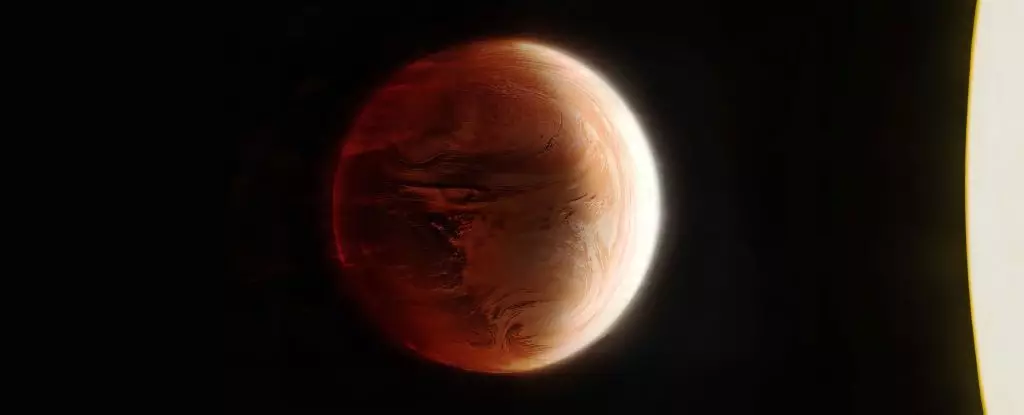Exoplanets, celestial bodies orbiting stars beyond our own, have fascinated scientists and the public alike for centuries. Among the vast array of confirmed exoplanets, Tylos (WASP-121b) stands out as a particularly remarkable case. Located 880 light-years away in the constellation Horologium, Tylos is not just another planet; it is a veritable cosmic anomaly that challenges our understanding of planetary atmospheres and weather systems.
Tylos is categorized as a ‘hot Jupiter,’ a classification that refers to gas giants located unusually close to their parent stars. While many exoplanets have been found to exhibit characteristics akin to known celestial bodies, Tylos elevates this concept to a stunning new level. With a radius approximately 1.74 times that of Jupiter and a mass about 1.16 times greater, Tylos orbits its host star, Dilmun, so closely that its orbital period lasts merely 30 hours. The consequence of this proximity is an astonishing equilibrium temperature of around 2,360 Kelvin (2,087 degrees Celsius or 3,788 degrees Fahrenheit), making it one of the hottest worlds known.
Notably, the intense heat does not just make Tylos inhospitable; it creates an atmospheric spectacle unlike anything witnessed within our Solar System. Research indicates that its atmosphere is composed of vaporized metals, with clouds of iron and titanium forming under these extreme conditions. In what seems more like a delightful fairy tale than empirical science, it rains liquid sapphires and rubies on Tylos, an image that incites awe and imagination.
The exploration of Tylos is not solely appealing due to its exotic materials; researchers have painstakingly begun to dissect its fervent atmosphere. Recent studies have successfully charted Tylos’ atmosphere in three dimensions, sparking revelations about its environmental dynamics. The findings illustrate an atmosphere where powerful jet streams circulate materials around the exoplanet’s equator. This atmospheric activity is remarkable because it breaks typical planetary weather paradigms. The mechanics at play are so astonishing that they lead astrophysicist Julia Victoria Seidel to compare Tylos’ meteorological behaviors to something that seems “out of science fiction.”
The measurements taken reveal jet streams that blow at supersonic speeds, a phenomena that dwarfs anything seen in our own atmospheric systems. With winds cranking up to 26.8 kilometers (16.7 miles) per second on the evening side, Tylos challenges even the most extreme weather recorded within our Solar System, where hurricanes appear to be mere whispers by comparison.
One of the fascinating aspects of Tylos is its tidally locked nature, meaning the same side faces its star while the other side continuously remains in darkness. This synchronous rotation creates significant temperature disparities, generating winds that swirl dramatically across the exoplanet’s surface. A temperature difference of approximately 950 Kelvin between the day and night sides intensifies these winds, resulting in complex weather systems that perpetually reshape the atmosphere.
This phenomenon raises a myriad of questions about atmospheric dynamics and behavior in extreme conditions. How do these wind patterns affect the distribution of elements throughout the planet? What does this mean for the potential for similar processes on other exoplanets? The possibility of discovering life in such hostile environments may seem far-fetched; however, understanding Tylos could unveil secrets that resonate across the wider cosmos.
The dizzying revelations from Tylos underscore the pioneering spirit of exoplanet exploration—a field passionately ablaze with questions and possibilities. As researchers utilize sophisticated tools like the Very Large Telescope to analyze these distant worlds, they gather invaluable insights that may reshape our fundamental understandings of the universe. With Tylos at the forefront, it serves as an inspiring testament to the ingenuity of modern astrophysics and our relentless curiosity about the universe.
The study of Tylos is not just an academic exercise; it symbolizes humanity’s quest to unravel the mysteries of the cosmos. As advanced technologies evolve and more discoveries unfold, our comprehension of such exoplanets will likely continue to deepen, sparking further exploration into the great unknown. Tylos, with its bizarre atmospheres and riddles of extreme weather, is a captivating snapshot of what’s out there—an outlier that continues to inspire awe and wonder.

